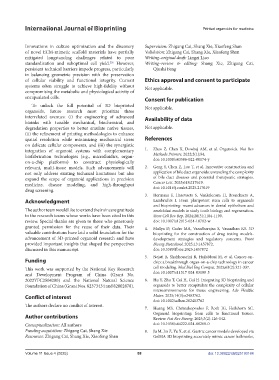Page 96 - v11i4
P. 96
International Journal of Bioprinting Printed organoids for medicine
Innovations in culture optimization and the discovery Supervision: Zhigang Cai, Shang Xie, Xiaofeng Shan
of novel ECM-mimetic scaffold materials have partially Validation: Zhigang Cai, Shang Xie, Xiaofeng Shan
mitigated longstanding challenges related to poor Writing–original draft: Lingzi Liao
standardization and suboptimal cell yield. However, Writing–review & editing: Shang Xie, Zhigang Cai,
226
persistent technical barriers impede progress, particularly Qiushi Feng
in balancing geometric precision with the preservation
of cellular viability and functional integrity. Current Ethics approval and consent to participate
systems often struggle to achieve high-fidelity without Not applicable.
compromising the metabolic and physiological activity of
encapsulated cells. Consent for publication
To unlock the full potential of 3D bioprinted
organoids, future research must prioritize three Not applicable.
interrelated avenues: (i) the engineering of advanced Availability of data
bioinks with tunable mechanical, biochemical, and
degradation properties to better emulate native tissues, Not applicable.
(ii) the refinement of printing methodologies to enhance
spatial resolution while minimizing mechanical stress References
on delicate cellular components, and (iii) the synergistic
integration of organoid systems with complementary 1. Zhao Z, Chen X, Dowbaj AM, et al. Organoids. Nat Rev
biofabrication technologies (e.g., microfluidics, organ- Methods Primers. 2022;2(1):94.
doi: 10.1038/s43586-022-00174-y
on-a-chip platforms) to construct physiologically
relevant, multi-tissue models. Such advancements will 2. Geng Y, Chen Z, Luo T, et al. Innovative construction and
not only address existing technical limitations but also application of bile duct organoids: unraveling the complexity
expand the scope of organoid applications in precision of bile duct diseases and potential therapeutic strategies.
medicine, disease modeling, and high-throughput Cancer Lett. 2025;618:217619.
doi: 10.1016/j.canlet.2025.217619
drug screening.
3. Hermans F, Hasevoets S, Vankelecom H, Bronckaers A,
Acknowledgment Lambrichts I. From pluripotent stem cells to organoids
and bioprinting: recent advances in dental epithelium and
The author team would like to extend their sincere gratitude ameloblast models to study tooth biology and regeneration.
to the research teams whose works have been cited in this Stem Cell Rev Rep. 2024;20(5):1184-1199.
review. Special thanks are given to those who generously doi: 10.1007/s12015-024-10702-w
granted permission for the reuse of their data. Their 4. Mallya D, Gadre MA, Varadharajan S, Vasanthan KS. 3D
valuable contributions have laid a solid foundation for the bioprinting for the construction of drug testing models-
advancement of 3D-printed organoid research and have development strategies and regulatory concerns. Front
provided important insights that shaped the perspectives Bioeng Biotechnol. 2025;13:1457872.
discussed in this manuscript. doi: 10.3389/fbioe.2025.1457872
5. Nejati B, Shahhosseini R, Hajiabbasi M, et al. Cancer-on-
Funding chip: a breakthrough organ-on-a-chip technology in cancer
This work was supported by the National Key Research cell modeling. Med Biol Eng Comput. 2025;63(2):321-337.
and Development Program of China (Grant No. doi: 10.1007/s11517-024-03199-5
2022YFC2504200) and the National Natural Science 6. Hu Y, Zhu T, Cui H, Cui H. Integrating 3D bioprinting and
Foundation of China (Grant Nos. 82373434 and 82002878). organoids to better recapitulate the complexity of cellular
microenvironments for tissue engineering. Adv Healthc
Conflict of interest Mater. 2025;14(3):e2403762.
doi: 10.1002/adhm.202403762
The authors declare no conflict of interest.
7. Huang MS, Christakopoulos F, Roth JG, Heilshorn SC.
Organoid bioprinting: from cells to functional tissues.
Author contributions Review. Nat Rev Bioeng. 2025;3(2):126-142.
Conceptualization: All authors doi: 10.1038/s44222-024-00268-0
Funding acquisition: Zhigang Cai, Shang Xie 8. Ju M, Jin Z, Yu X, et al. Gastric cancer models developed via
Resources: Zhigang Cai, Shang Xie, Xiaofeng Shan GelMA 3D bioprinting accurately mimic cancer hallmarks,
Volume 11 Issue 4 (2025) 88 doi: 10.36922/IJB025190184

